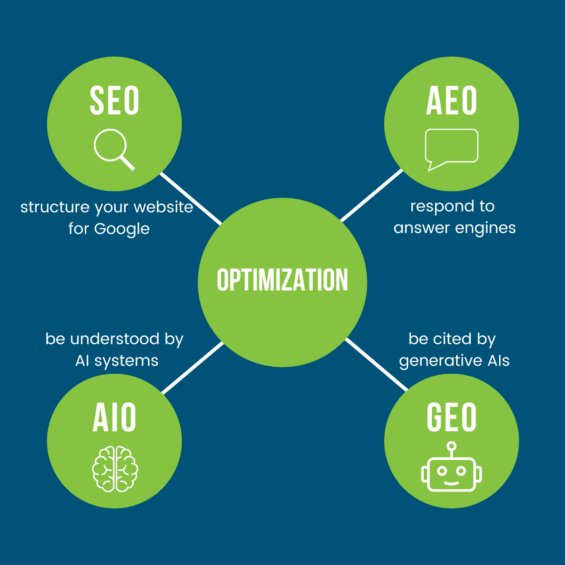From SEO to AIO: When Optimization Becomes Conversational

For a long time, the reflex was simple: optimize your website for Google.
SEO (Search Engine Optimization) dictated how to create content, structure a site, and get visibility.
However, the digital landscape has undergone significant changes. Today, your clients get information through Google, voice search, generative AI tools, and even their own internal systems. For businesses, this means one thing: optimization must now be viewed as an interconnected system that serves the customer experience.
Welcome to the era of conversational optimization.
This evolution is built around four complementary levers:
- SEO to be found
- AEO to be cited as the best answer
- GEO to be understood and relayed by generative engines
- AIO to be read, classified, and used by artificial intelligence systems

1. SEO – Being Found by Search Engines
SEO (Search Engine Optimization) remains the foundation. It aims to improve your visibility in traditional search results.
This involves:
- Strategically chosen keywords
- A clear page structure (titles, tags, internal links)
- Useful, original content
- A smooth user experience
But the rules have evolved: it is no longer enough to simply “please Google.” Today, SEO is the foundation that enables the other levers – AEO, GEO, and AIO – to work effectively.
💡 Key takeaway: SEO is not disappearing; it is evolving and becoming an integral part of an integrated strategy.
2. AEO – Responding to Answer Engines
AEO (Answer Engine Optimization) transforms the logic of search.
The goal is no longer just to appear in a list of links, but to be cited as the best answer to a question. Answer engines like Google SGE, ChatGPT, or Perplexity do not “search”: they “summarize.”
To make your company appear in these summaries, your content must:
- Answer specific questions clearly
- Use natural and contextual language
- Be validated by reliable sources
- Demonstrate expertise without unnecessary jargon
💬 Key takeaway: You are no longer writing for an algorithm, but for a conversation.
3. GEO – Optimizing for Generative Engines
GEO (Generative Engine Optimization) is the new frontier of content marketing. It is about optimizing your content so that it is understood, referenced, and cited by generative AI systems. Unlike traditional SEO, GEO ensures your content becomes part of the knowledge base of large language models and is recognized as a trusted reference.
To achieve this, you should:
- Create original, factual, and well-sourced content
- Structure your pages for AI readability (clear titles, citations, and context)
- Connect your content pieces to strengthen thematic authority
- Maintain consistency in tone and messaging across your digital channels
💡 Quick exercise: test your generative presence
- Open ChatGPT, Gemini, Perplexity or any other generative AI tool.
- Ask a question your customers often ask, such as: “What are the key trends shaping my industry right now?” or “How can a small business build customer loyalty?”
- Look at which organizations, examples, or sources are mentioned.
- Ask yourself: could my content have been referenced here?
If not, it may be time to strengthen your GEO strategy so your insights become trusted references that AI tools naturally surface.
4. AIO – Being Understood by Artificial Intelligence Systems
AIO (Artificial Intelligence Optimization) is about making your content understandable to AI systems, whether generative or analytical. This applies both to public models (ChatGPT, Gemini) and to your clients’ internal systems (CRMs, knowledge bases, procurement platforms).
To achieve this, your content should:
- Be clearly structured (titles, sections, logical hierarchy)
- Use consistent terminology
- Provide explicit context (who, what, why, how)
- Include concrete data, examples, and insights.
💡 Key takeaway: AIO ensures your content can be read, classified, and reused by AI systems.
What This Means for Small and Medium Businesses
For SMEs, this evolution requires a change in mindset.
It is no longer about producing content for Google, but about building an integrated digital presence strategy. Every text, every page, and every post should contribute to a coherent and connected experience.
Here are a few examples of how leading organizations apply these principles:
- Airbnb: optimizes listings for voice and AI search (AEO) with clear, structured descriptions.
- HubSpot: publishes structured, interlinked content often referenced by generative AIs (GEO).
- Canva: builds well-tagged guides and tutorials, making them easily readable by AI databases (AIO).
- Decathlon Canada: strengthens its local visibility through SEO while optimizing product listings for conversational engines.
Thinking about your content through the lens of SEO, AEO, GEO, and AIO means putting humans and intelligence back at the heart of digital marketing.
Category
Share

